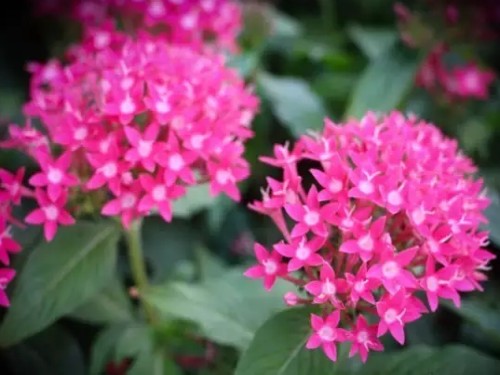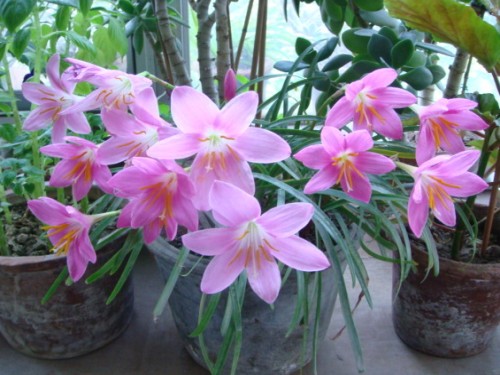How to raise starry flowers-the culture method of starry flowers
Starry flowers, also known as five-star flowers. Rubiaceae, flowers of the genus Rubiaceae. Like the warm and sunny environment, if domestic, it is suitable to be placed on the windowsill with long sunshine. Star flowers generally have umbrella-shaped panicles at the top of each branch, which need to be supplemented with acidic P and K fertilizer in time; cut off the residual flowers after flower fade to concentrate nutrition and promote the formation of new branches to form a new round of flowers. When the temperature drops in late autumn, the growth tends to stagnate; it needs to be kept warm and overwintered in winter, and it will blossom again in the second year when the maintenance is strengthened.

Star flowers, Rubiaceae perennial herbaceous flowers. General plant height 30 cm to 40 cm, stem erect, strong branching, leaves opposite, lanceolate, leaf tip acuminate, 6 cm to 8 cm long, terminal cymose inflorescence, floret tube-shaped, color 5-split into five-pointed star, hence the name Wuxing flower. Dozens of five-star flowers gather into clusters, which are very gorgeous and pleasing to the eye. Native to tropical Africa or cultivated, perennial grass flowers with persistent roots, drought and high temperature tolerance, long-lasting florescence, pink, scarlet, peach, white and other flowers, the flowering period is mainly concentrated in March-October, suitable for potted plants and layout of flower beds, flower beds and landscape layout.
Soil:
Use peat soil that is sterile, slightly fertilized and well drained. The pH value should be 6. 5-6. 8 to avoid iron poisoning and magnesium deficiency. If the pH value is lower than 6.0, due to iron poisoning, there will be a serious leaf edge burning phenomenon, which will make the plant stop growing.
Lighting:
Starry flowers like the environment where there is plenty of sunshine. The stronger the light is, the tighter and stronger the plant is. Therefore, in the winter of weak light and short days, attention should be paid to supplementary illumination.
Temperature:
Warm heat and sufficient sunshine contribute to the growth of star flowers. During the growth period, the night temperature should be kept above 17-18 ℃, and the daily temperature should be above 22-24 ℃. Temperatures below 10 ℃ will cause irregular flowering and delay or hinder the blooming of flowers.
Moisture:
Star flowers are more resistant to drought, but not to water and moisture. During the growth period, excessive watering should be avoided, and stagnant water in the cultivation medium should be avoided so as not to induce root rot. When watering, the water temperature should not be too low (that is, the water temperature should be consistent with the medium temperature). Excessive watering will often yellowing the plant and slow the growth of flowers.
Fertilization:
800-1000 times of chlorophyllin was applied one week after planting, and it was irrigated every 7-10 days. When the plant enters the middle stage of growth (that is, the plant height is 8-10 cm), 800-1000 times of "flowering essence" can be applied once a week to promote flower bud differentiation and growth.
Diseases and insect pests:
The main diseases and insect pests are gray leaf spot, red spider, whitefly, aphid and so on. Preventive methods include keeping the cultivation site clean, using sterile soil, cultivation medium and pot, etc.
Time: 2019-06-01 Click:
- Prev

How to raise bonsai of lobular banyan tree
Small leaf banyan has the advantages of beautiful shape, beautiful root, beautiful branches, beautiful skin color, beautiful leaves and beautiful whisker roots. Because of its strong root system, numerous branches and leaves, easy growth, resistance to pruning, long life, magical variety and unique shape, the banyan tree has become an excellent material for cultivating bonsai stumps and is favored by many bonsai lovers. Today
- Next

Culture method of onion orchid
Green onion orchid, scientific name green onion lotus (Zephyranthescandida), also known as Yulian, green onion orchid and so on, perennial herbs. The whole herb with bulb is a kind of folk herbal medicine, which has the effect of calming the liver, calming the heart, extinguishing the wind and calming the wind. It is mainly used to treat infantile wind and epilepsy.
Related
- Fuxing push coffee new agricultural production and marketing class: lack of small-scale processing plants
- Jujube rice field leisure farm deep ploughing Yilan for five years to create a space for organic food and play
- Nongyu Farm-A trial of organic papaya for brave women with advanced technology
- Four points for attention in the prevention and control of diseases and insect pests of edible fungi
- How to add nutrient solution to Edible Fungi
- Is there any good way to control edible fungus mites?
- Open Inoculation Technology of Edible Fungi
- Is there any clever way to use fertilizer for edible fungus in winter?
- What agents are used to kill the pathogens of edible fungi in the mushroom shed?
- Rapid drying of Edible Fungi

